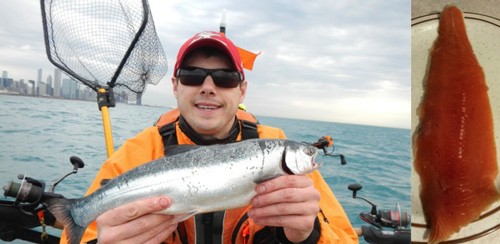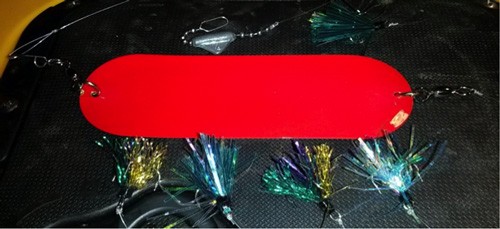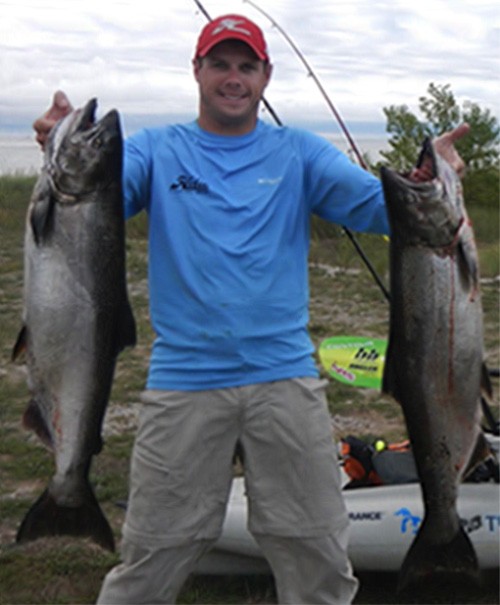Though every kayak angler I meet is different with unique stories and talents, I have found a common trait; if they had not yet caught a salmon from Lake Michigan in their kayak, they have wanted to. However, most of them thought it would be too complicated or not feasible based on their perceptions of salmon fishing. Well, you can catch salmon in your kayak, and it is not as complicated as you might think. Most likely, you do have the right gear, and if you know the basic principles, you will catch fish this season.
I always tell people to treat Lake Michigan like it is an ocean. I say this because Lake Michigan can be very dangerous during certain weather conditions and this must always be remembered. Ideally, you want the swell to be less than two feet. It is wise for beginners not to venture out into waters alone. In all situations it is safest to stay close to shore, have a properly functioning marine radio, and fish near bigger harbors like Milwaukee or Chicago. Take into account the water and air temperatures; I always wear my NRS Chinook PFD and Kokatat Tropos dry suit when the weather demands it to stay warm in cold conditions.
Coho Salmon
Some of the best Coho Salmon fishing on the lake stretches between Waukegan, Illinois and south towards Gary, Indiana. However, the King Salmon fishing tends to be better up north between Milwaukee Harbor and Manitowoc, Wisconsin, and it is my personal opinion that the fish get bigger the further north you are.
The months of April and early May are the best time to catch Coho Salmon. While the fish that are accessible are smaller this time of year, the quality of the meat is amazing and it is the reddest flesh you will find in any freshwater fish. However, when the Coho Salmon come back to spawn in the late fall they are much larger fish in the 10-15 pound range and they have undergone a transformation in order to prepare for spawning; they change color, get hooked or curved jaws, and are basically dying. Unfortunately, eating these fish is usually not a good idea this time of year because the meat is spoiling due to the fish exerting all of its energy into the spawning process, which ultimately proves deadly for them.


Coho Salmon put up a tremendous fight and they love to jump, spin and do death rolls similar to that of an alligator, especially once you get them in the net. It is not uncommon to have a 50% catch rate of fish you have hooked while trolling. In the spring, Coho Salmon are found in areas that have warmer and more hospitable waters such as harbors, tributaries, and especially in or around power plants and other point sources of warm water discharge. This is because these areas traditionally hold more baitfish year round.
I prefer lighter fishing gear so I can see hits better, thus giving me a better chance to set the hook. I use a 7-foot medium light spinning rod with 8-10 pound fluorocarbon or monofilament line on it. Early in the season when the water is still pretty cold, I stick to crankbaits 90 percent of the time – AR Lures are my preferred trolling crankbaits. When the water temperatures begin to get closer to 50 degrees (usually closer to May) then I will be running orange dodgers with peanut flies almost exclusively. I troll three lines off my Pro Angler 14 by utilizing mini planner boards made by Offshore Tackle Company. They are florescent yellow making them easy to see. This allows me to run a line straight down the back or middle of my kayak. I troll at about 2.1 mph because this is right in the middle of the optimal range of speed. Rather than trolling in a straight line, I make gradual S-turns to reach my destination. This method allows me to cover more water while at the same time helps find the best speed to troll at for the day. For instance, if fish are hitting my outside line, I will increase my trolling speed; if they hit the inside line I will slow down. Once I find that optimal speed, I stick to it and stay on a straighter path.


King Salmon or Chinook Salmon
In the spring, king salmon can be caught closer to shore as they follow baitfish into shallow waters. However, they are unpredictable and very hard to track down in a kayak this time of year. As summer progresses, they begin to move farther offshore in search of cooler waters and you will find salmon 100 feet below the surface in 200 feet or more of water. There are ways to target these fish in a kayak, but it can prove to be extremely difficult. Therefore, fishing for king salmon in a kayak is usually done in late summer or early fall. The kings will begin to “stage,” and congregate in numbers at tributary mouths and harbors across the lake as they prepare for their fall spawning run up rivers. Fish are concentrated in 20-50 feet of water. It is not uncommon to catch 25 and 30 pound fish this time of year.


King salmon are extremely powerful, have an enormous amount of energy, and take a good deal of time to tire out before netting them. I still try to run three rods at all times if it is not too wavy or windy. When the weather becomes more adverse and you try to run three lines, you will be spending most of your time untangling messes. Lines cross and get twisted up much more frequently. I prefer a large spinning rod and reel combo because it allows me to adjust my drag with ease when a salmon runs or changes direction abruptly. While trolling, rod sensitivity is not very important to me. I use an Ugly Stick Salmon/Steelhead Rod that is 8’6” medium heavy as it can take the abuse and the price is right. I pair these rods with a Penn Battle Spinning reel loaded with 30 pound braided line and a 15-20 pound fluorocarbon leader.
There are a few basic types of salmon trolling lures and attractants: plugs, flasher and fly combo, large crankbaits, and trolling spoons. I do not use flasher and fly combos or j-plugs to often from my kayak. The Rapala DT16 is a great example of good salmon lure that just needs to have upgraded hooks and split rings before it gets wet. One of my favorite trolling lures is the Brads Killerfish, one of my go to baits in the fall. King Salmon hone in on their food by feeling vibrations in the water, so baits that have internal rattles and have a powerful wobble action tend to work the best. Trolling spoons, on the other hand, rely more on the fish’s sense of sight. As they flutter and shimmer through the water, they mimic a wounded baitfish.


Fishing for Coho and King Salmon on Lake Michigan can seem like a daunting task to any kayak angler. With the right knowledge, a good safety plan, and proper outerwear the task becomes very possible even for those first timers out on the “Big Pond”.
Remember that every chance you get out on the water, whether a fish is caught or not, is still a chance to learn and refine your salmon trolling techniques.